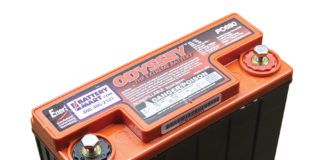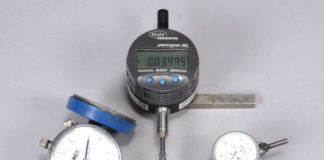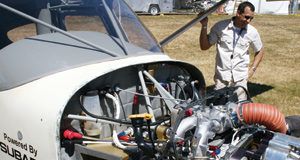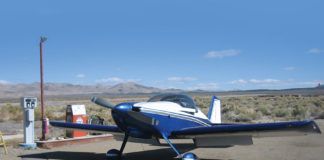If it seems like we’ve been going on and on about electronic flight instrument systems (known also by the unwieldy EFIS acronym), you’re right. We have. But its a reaction to the marketplace for new installations.
I also recognize that there’s a place for traditional instrument packages-round dials, mechanical gyros, discrete devices-and were going to talk this month about the benefits (and weaknesses) of this technology.
Here, we can benefit from my own experience. I fly what today would be considered an older-generation RV-6. I often get comments (I wont say nasty) from people after they see the instrument panel. You see, its filled with basic old-generation steam gauges, complete with a vacuum-powered artificial horizon (AI) and a directional gyro (DG).
As Me Why
People wonder why my plane would have such old-school instruments when my shop is busy building the most high-end EFIS panels available. Well, heres the truth, on many levels. First, that was the only stuff available when we built the plane. Second, I just don’t need it. Third, I simply couldn’t afford the high-end widgets even if I wanted them. (And you thought avionics shops printed money…)
Sure, it would be nice to have a big glass panel, huge moving map with traffic, satellite weather and a built-in music player, but my basic round gauges, simple radio stack and handheld GPS get me everywhere I need to go. Im fully legal for IFR flight, have onboard weather (thanks to my nifty little Garmin), and my simple autopilot makes everything easy. I still have a rather old looking VOR/GS/ILS indicator-hey, it works.
My airplane proves there is still a place for good old round gauges. Affectionately, we refer to them as steam gauges, in part due to their similarity to the displays in old trains and such. Many people are still building truly affordable planes, and often they are completing the entire plane for less than a new Lycoming engine costs! Some are building day/VFR fun-flying machines and have recognized that the latest gizmos only add weight to the airplane and cost to the building process. Learn from them. Those of you building such an airplane will have little use for expensive high-end electric instruments.
There are pros and cons to going with glass over steam gauges. Lets take steam gauges system by system, and Ill help you avoid the mistakes that I and others have made in this arena. You conservative EFIS buyers take note of these recommendations for buying backup instruments.
The Pitot-Static Instruments
Primary flight instruments would be airspeed and altitude, so you need an airspeed indicator and an altimeter. Duh. Both instruments in their simplest forms are purely mechanical devices that basically display their associated parameters. Airspeed indicators measure the difference between the pitot pressure and static pressure of the aircraft. Its important to realize that the airspeed displayed is a simple indication of the aircrafts relative airspeed through the air around it. This does not account for variations in temperature and pressure, which would give you true airspeed.
Most airspeed indicators are available in a variety of sizes and configurations, including a display in knots, mph or both, as well as specific range markings for your aircraft. They can often be purchased with optional internal lighting at an additional cost. As a whole, most airspeed indicators are fairly trouble-free instruments that will last many years. Costs range from $150 to $1000 depending on whether the unit is certified or non-certified. My experience is that the better non-certified instruments will work fine, and the added cost of the certified device is not always warranted.
An altimeter in its simplest form is a mechanical instrument that uses static pressure measured against a reference pressure inside the instrument to display an altitude-essentially a very sensitive barometer. Altimeters are available in both sensitive and non-sensitive versions.
Sensitive altimeters are the ones you’re used to seeing, the three-pointer versions with individual hands for hundreds, thousands and tens of thousands feet. Again, we have the choice of certified or non-certified models. The issue here is that the certified models have skyrocketed in price, with the least expensive United going for more than $700. The price goes way up if you opt for an internal encoder to feed your transponder. This configuration was popular for many years in production aircraft, but I don’t recommend it. A non-TSOd altimeter and a TSOd blind encoder are cheaper and benefit from redundancy; with a combined unit, a failure of either the altimeter or the encoder means the instrument has to come out and be repaired. Not a good trade-off, in my view.
Non-sensitive types are not, as the name implies, either less accurate or incapable of providing sympathy after a bad landing. “There, there…you’ll do better next time.” Nope, this term simply refers to a lack of hands-as opposed to, say, just a lack of fingers. Non-sensitive altimeters have a single pointer, so that the range of the device-the maximum altitude its designed to show-is given in one revolution of the pointer. That packs a lot of information into a small dial, especially if you use a 2.25-inch version, making a non-sensitive altimeter much harder to read. However, they’re less expensive and make a fine backup to an EFIS. I would not recommend a non-sensitive altimeter for primary use, even VFR.
Vertical speed indicators are the third mechanical flight instrument typically hooked up to the pitot-static system. Most powered aircraft use VSIs, and most non-powered aircraft (gliders) install a more precise variometer. Variometers installed in gliders are typically sensitive to even minute changes in altitude and often have an audio output that varies according to climb or descent rate. Costs for VSIs can range from $150 to more than $700 depending on sensitivity, size and features.
Failure modes for these basic pitot-static instruments are usually sticky needles after many years, or small leaks in the cases of the instruments. Overhauls are relatively easy and cheap, and used instruments are readily available on the surplus market. As far as certified versus non-certified instruments, the certified instruments often offer a bit higher quality construction. However, many non-certified instruments have proven to be quite reliable as well. Most are American-made, though some foreign-made instruments (Asia and Europe) are also available. Our experience has been that the U.S. and European units seem to be quite good, while the overall reliability of the Chinese units has been somewhat mixed; many customers seem to have good luck with the import units.
It’s Lunchtime, So Let’s Talk Gyros
Next of importance (and required for an IFR installation) are gyroscopic indicators-normally the attitude indicator and the directional gyro. If you’re a day/VFR-only pilot in a day/VFR airplane, you probably don’t need a full gyro pack. If you’re worried about maintaining wings-level in low-visibility conditions, or think youd like some help if you ever inadvertently wander into instrument conditions, it might be worth the investment. However, many pilots are well served with just a turn coordinator or turn-and-bank indicator-nothing fancy, just enough to keep the wings level and get you back to VFR conditions. Night is another matter altogether, as well discuss shortly.
But first lets talk about IFR equipment. Gyro-based indicators can be either electrically powered or, historically and most commonly, powered by a vacuum source (either engine driven or via an external venturi).
Gyroscopically based AIs have been around for more than 50 years, and their design has changed surprisingly little. Improvements have been made, but the general function has remained fairly similar. Driven by either air or an electric motor, the indicator houses a wheel-shaped chunk of metal spinning at very high rpm with appropriate indications attached to it. As the airplane banks or rolls, the gyro desires to stay in the same spot, and it provides an associated movement on the instrument face.
One limitation to mechanical gyro-based AIs is the fact that the spinning gyro and assembly inside the case normally cannot travel a full 360 of roll and 360 of pitch without hitting physical stops or limits in the instrument. When the gyro hits these stops it causes a “tumble” in which the display will act erratic and be unusable. This is not an issue for normal flying, but any unusual attitudes will typically wreak havoc on the internal gyro mechanism over time. Some gyros are available with a caging function that allows the pilot to reset the gyro to flat/level flight attitude.
Traditional vacuum-driven gyros are still popular in some installations, but the latest generations of mechanical attitude indicators are electrically driven. Several companies are now offering electric AIs with built-in batteries that allow the unit to be run in an emergency free from the aircraft power source. They are much more expensive than their vacuum-powered friends, but reliably is arguably better. Also, the cost of a full electric AI/DG combination can be comparable to a vacuum system when you include the cost of the vacuum pump, regulator, filter, plumbing and the fittings.
The DG is sometimes and historically also referred to as a heading indicator. It is similar to an AI in design with the exception that the internal spinning gyro is fixed in one axis and only moves about the lateral axis (yaw), displaying the heading of the aircraft on a simple circular compass rose display. Directional gyros may also be electric or vacuum powered with the preponderance of them being vacuum powered. There are more advanced DGs that use external devices to improve accuracy, but those are not within a typical builders price range, so the most affordable version is usually vacuum or electrically powered.
Again, our experience with U.S. made DGs and AIs has been very good. The same is true for the European gyros, but our experience with the Chinese imported gyros has been poor. Costs for typical DGs and AIs can range from $400 to $4000 depending on certification, internal batteries, caging, lighting and whether the unit is electrically powered or vacuum powered. Electrically powered attitude and directional gyros are significantly more expensive than vacuum powered ones, but they do not depend on failure-prone vacuum pumps to operate.
Last but not least when it comes to gyroscopic instruments is the turn coordinator and its older cousin, the turn and bank. Both instruments have a spinning gyro inside of them, but fixed only in one axis, meant to give the pilot an indication of turn rate. The turn coordinator senses bank with its internal gyro, and the display indicates a standard-rate turn. The turn and bank purely senses rate of turn and provides no indication as to the roll axis of the airplane. Both instruments will typically have a skid ball installed to show the pilot if the airplane is in a slip or skid, thereby allowing for coordinated turns. These instruments are normally electrically powered, though there have been vacuum-powered versions as well. Again, our experience with American or European instruments has shown them to be the most reliable and consistent.
Powerplant Instruments
If you’re building a nice day/VFR fun flier with an affordable engine, and you don’t have a requirement to see all EGTs, CHTs, fuel flow and fuel pressures, then perhaps a few strategically chosen engine gauges would be a wise choice. Reading through magazines and looking at all the fancy panels we turn out, you might assume that everyone in the world either has or wants a big glass graphical type engine monitor. Sure they are nice, but do you really need it? One of my favorite airplanes to fly is a friends all-original 1946 Airknocker. With its 65-horsepower engine, no electrical system and no avionics, the only engine instruments are the bare minimums. Tachometer, oil pressure and oil temp-thats it! Sometimes you just don’t need all the extra gauges.
Engine gauges, whether electric or mechanical, are very reasonably priced. Many of the instruments we use in homebuilts are copies of automotive products and are priced accordingly. Typical instruments for engine parameters cost $35 to $100. Some of the best values in standard 2.25-inch engine instruments are from Vans Aircraft, which has a line of nice gauges with full needle sweeps in the sub-$100 range. Don’t forget when ordering an engine instrument that you will also need to purchase the associated sensor/sender for the specific gauge. If you outfit your aircraft with the minimum required engine instruments, you should be able to get by for about $250 or less. Of course, if you go wild and start purchasing a bunch of other instruments, then you’ll soon be reaching the price of some graphical/electrical engine monitors.
Electronic Steam Gauges…What?
I know. This article was supposed to be about traditional instruments. But a number of products don’t quite fit the EFIS/EIS definition, but they also don’t fit the old steam gauge meaning either. These are the newer generation electronic displays for both flight and engine instruments.
One of the more popular manufacturers of low-cost single instruments is MGL Avionics, which offers “singles,” available in a range of sizes and configurations that include singular flight instruments, combinations of flight instruments and a variety of engine instruments. They are neatly packaged in lightweight 2.25- or 3.125-inch instruments complete with a nice graphical display for $100 to $400. The company offers too many options to list individually here.
There is also a unique manufacturer of a flight instrument. TruTrak Flight Systems has a pictorial turn-and-bank type unit thats a solid-state turn coordinator-style instrument in 2.25- or 3.125-inch sizes. TruTrak also has the attitude direction indicator, which is a quasi attitude indicator and DG in one box. It displays both pitch and roll via solid-state sensors. The ADI is also available in 2.25 or 3.125-inch sizes and can be installed with an optional backup battery. The ADI has proven to be extremely popular even though its not a true gyro driven indicator. It uses a combination of solid-state sensors along with pitot-static information to display pitch/roll/yaw information along with vertical speed-the so-called pitch bar really isnt; its vertical speed. The DG portion is actually GPS ground track, available from your onboard GPS (via an RS-232 serial connection) or by an optional internal GPS receiver. Reliability of the ADI has been fairly good overall with few failures.
Stein’s Rules for Steam Gauges
Thou shall not waste money needlessly. If you are building a day VFR fun flier and you don’t want to expend much money on the panel, then there is no reason to invest more in the panel than the entire airplane is worth! Also, if you buy too many steam gauges you’ll be nearly at the same price as lower cost graphical displays, so choose carefully. Thou shall not install instruments you’ll never use or need. If your homebuilt plane has only two cylinders, you don’t need to buy a four-cylinder, whiz-bang bar graph analyzer. If the plane uses transparent fuel tanks or has a glass tube sight indicator, there is no need for complex fuel level senders or a fuel computer. Also, if you’re building a nice day-only VFR plane for puddle jumping, you don’t need three EFIS screens, and if the top speed of the plane is 65 mph with a best climb of 250 fpm, you don’t need an airspeed indicator that goes to 250 mph and a VSI with a 4000-fpm display. (Unless, of course, you bought them used for pocket change.)
Thou shall not install instruments you’ll never use or need. If your homebuilt plane has only two cylinders, you don’t need to buy a four-cylinder, whiz-bang bar graph analyzer. If the plane uses transparent fuel tanks or has a glass tube sight indicator, there is no need for complex fuel level senders or a fuel computer. Also, if you’re building a nice day-only VFR plane for puddle jumping, you don’t need three EFIS screens, and if the top speed of the plane is 65 mph with a best climb of 250 fpm, you don’t need an airspeed indicator that goes to 250 mph and a VSI with a 4000-fpm display. (Unless, of course, you bought them used for pocket change.)
Thou shall embrace modern versions of old classics. Many manufacturers are making newer versions of old looking instruments such as attitude indicators, directional gyros, engine instruments and flight instruments, which, in some cases, have digital displays as well. They almost always weigh less, use less electricity and are usually more reliable.
The line between standard round gauges and newer generation instruments is becoming cloudier every day. Even the airlines that always used to have gyro driven “peanut” sized backups are moving toward small graphically displayed instruments. At airshows this summer we will see new instruments from gyro manufacturers that are approaching what would almost qualify as an EFIS, but mounted in a conventional circular hole. Engine instruments are also quickly becoming more advanced and modern, combining multiple functions into single “smart” instruments. There is no reason to be afraid of this new technology.
If you have specific questions for author Stein Bruch, or have certain projects youd like us to cover, email us at [email protected] with “About Avionics” in the subject line.













